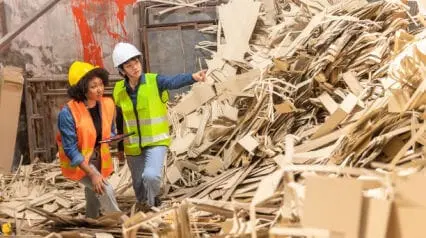What is Industrial Waste Management?
Industrial waste management involves collecting, transporting, treating, and disposing of an organization’s industrial waste. This includes everything from contaminated soil and dry pesticides all the way to chemical waste. The entire process revolves around responsibly and efficiently disposing of this waste, reducing the organization’s environmental impact and costs.
Importance
It’s crucial for modern businesses to practice proper industrial waste management. Since this waste can be hazardous, proper disposal is essential to ensure that you don’t harm the environment, employees, and people around you. This is why most organizations pour a lot of time and effort into their industrial waste management practices and why it might be about time for you to start beefing up your processes as well.
Aside from helping organizations reduce their environmental impact, proper waste management boosts efficiency while reducing costs. This is because handling and managing your waste the right way is much more cost-effective than letting it pile up and cause problems down the line.
On top of that, industrial waste management can also improve your public relations. Nowadays, the public is very concerned about green and eco-friendly practices. So, showing that you and the organization practice responsible industrial waste management is a great way to improve your business’s reputation in the market.
Types of Industrial Waste
There are various types of industrial waste. And to properly manage this waste, it’s important to understand the different types of industrial waste your organization may be creating. Generally, industrial waste is divided into hazardous and non-hazardous categories. But to better understand the types of waste, we’ve divided it into four categories, which are:
Hazardous Waste
This type of waste poses an immediate and significant threat to the environment and human health. Examples of hazardous waste include chemicals, pesticides, batteries, and electronic or e-waste.
Non-Hazardous Waste
This is the type of waste that doesn’t severely impact the environment and human health. Typically, this type of waste arises out of normal business operations. Examples of non-hazardous industrial waste include paper, cardboard, wood, and plastic.
Radioactive Waste
This is industrial waste that has radioactive properties. Typically, this waste comes from organizations like nuclear power plants and healthcare facilities. These substances cause significant harm to living organisms, which is proper waste management is crucial.
Organic Waste
This is biodegradable waste that comes from business activities and operations. This can include food, agricultural waste, sewage, and more.
Best Practices for Industrial Waste Management
Industrial waste management can look different for every business and organization. This is why it’s important to create a team that can pinpoint all the industrial waste that the organization produces and the best ways to manage the waste. And while every organization’s industrial waste management process may look different, there are certain best practices you may want to adopt. These practices include:
- Reduce, reuse, and recycle waste in your organization
- Train employees in the company’s waste management practices
- Use licensed transporters for your hazardous waste to ensure safe disposal
- Constantly gauge your waste management practices and make the necessary improvements
- Identify the waste your organization produces
- Ensure that all employees segregate the waste they produce




